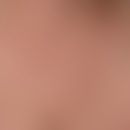Definition
Synthetisches polyaromatisches Retinoid der dritten Generation mit antientzündlicher Wirksamkeit. Keratolytikum.
Indikation
Zugelassen für die Aknetherapie, z.B. Acne comedonica, Acne papulopustulosa. Gute Effekte bei aktinischen Keratosen und Lentigines wurden durch die tägliche Anwendung eines 0,3% Gels erzielt ( Off-Label-Use).
Auch interessant
Dosierung und Art der Anwendung
1mal/Tag nach gründlicher Hautreinigung auf das gesamte befallene Hautareal dünn auftragen. Behandlungsdauer i.A. bis zu 12 Wochen.
Hinweis(e)
Merke! Kein längeres Sonnenbaden oder UV-Bestrahlung unter der Therapie (Phototoxizität). Vorsicht auch im Hochgebirge und an der See!
LiteraturFür Zugriff auf PubMed Studien mit nur einem Klick empfehlen wir  Kopernio
Kopernio
 Kopernio
Kopernio- Gollnick H (2003) Current concepts of the pathogenesis of acne: implications for drug treatment. Drugs 63: 1579-1596
- Gollnick HP, Krautheim A (2003) Topical treatment in acne: current status and future aspects. Dermatology 206: 29-36
- Greenspan A et al. (2003) Cumulative irritation comparison of adapalene gel and solution with 2 tazarotene gels and 3 tretinoin formulations. Cutis 2003 72: 76-81
- Ioannides D et al. (2002) Topical adapalene gel 0.1% vs. isotretinoin gel 0.05% in the treatment of acne vulgaris: a randomized open-label clinical trial. Br J Dermatol 147: 523-527
- Millikan LE (2003) The rationale for using a topical retinoid for inflammatory acne. Am J Clin Dermatol 4: 75-80




